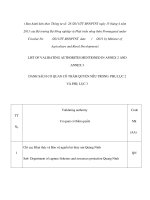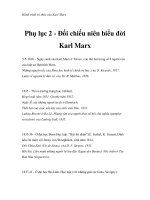Phụ lục 2 du gio quyen
Bạn đang xem bản rút gọn của tài liệu. Xem và tải ngay bản đầy đủ của tài liệu tại đây (242.48 KB, 5 trang )
Phụ lục 2: HƯỚNG DẪN DỰ GIỜ VÀ RÚT KINH NGHIỆM GIỜ DẠY
(Ghi vào sổ KTSP VÀ TTSP) (*)
Thứ ... ngày .... tháng .... năm ......
Giáo viên (SV) dạy: ............................. Tiết thứ: ........... Lớp: ..........................
Môn học: .............................................................................................................
Bài dạy: ................................................................................................................
Họ tên số SV đã dự: .............................................................................................
Họ tên giáo viên ĐHSP (nếu có) và trường thực tập dự: .....................................
...............................................................................................................................
I. Chuẩn bị trước khi dự giờ:
ĐỀ CƯƠNG BÀI DẠY
1.
LESSON PLAN
2.
English 10
Unit 3: Music
3. Time: 45 minutes
Lesson 3: Reading (p.31)
Student’s level: 10th grader (CEFR: A2, B1-) 4.
STAGE 1: DESIRED OBJECTIVES
A. Objectives
By the end of the lesson, students will be able to:
1.
2.
3.
4.
Read for specific information in a text about a famous TV music show
Guess the meaning of words/ phrases in context
Talk about reasons why they want or don’t want to participate in a music competition
Recognise different musical shows
B. Language Focus
Key terms: judge, participant, eliminate, competition
Key grammar/ structure: not only… but also, relative clause (Who)
C. Instructional resources
- Grade 10 textbook, unit 3, reading
- Computer connected to the internet
- Projector/ TV/ Pictures and cards
STAGE 2 – ASSESSMENT EVIDENCE
Performance Tasks
1. Look at the pictures and discuss the
following questions
Performance
products
Student’s answer
2. Read a text about a fomous music show
and match.
Student’s answer
3. Read a text again and choose the best
Student’s answer
Assessment
tools
Answer key,
Observation
Answer key,
Observation
Observation
answers
Peer correction
4. Discuss whether you want to participate
in Vietnam idol. Give reasons
Questions &
answers
Observation
Peer correction,
Reflection,
report
Work in pairs
STAGE 3 – LEARNING PLAN/ LEARNING EXPERIENCES
Activity 1: Warmer
- Teacher asks students to observe 2 pictures of the singing competition
- Teacher asks students the following questions about video and elicit their answers.
a. What program is this? (vietnam idol, the masked singer)
b.How often do you watch it?
- Call on some students to share their opinions, and encourage different viewpoints.
- Lay out the mind map to lead students to the new lesson.
Activity 2: Vocabulary pre-teach
- Ask students to look at the reading passage on page 3
- Provide student with the meaning and pronunciation of some new words.
+ Series(n) / ˈsɪəriːz /: Chuỗi (explain meaning and pronounciation )
+ Judge (v): Ban giám khảo (use image to lead to word)
+ Competition(n)/ ˌkɒmpəˈtɪʃn/: Cuộc thi (use image to lead to word)
+ Eliminated (v) / ɪˈlɪmɪneɪt/: Loại trừ (Explain meaning)
+ Participant (n) / pɑːˈtɪsɪpənt/: Người tham gia (Explain meaning and pronounciation)
+ Semi-final (n) /ˌsemi ˈfaɪnl/: Bán kết (Give the Vietnamese meaning and then lead to the
English word)
-
Ask students listen and repeat the words.
Ss practice the words in pairs and two students read the words out loud in front of the
class.
-
Teacher checks students’ understanding by the “Rub out and remember” technique.
Activity 3: Look at the pictures and discuss the following questions
What are these shows? What do you know about them?
- Ask Ss to work in pairs to look at the pictures and discuss the questions.
- Focuse their attention on the logos and the names of the shows.
Call on some students to share their opinions, and encourage different viewpoints
Give comments and leads in.
Activity 4: Read and match
- Analyze to help students understand the exact task requirements
- Ask students to work in pairs, skim through the article to to get an overall idea, paying
attention to the context of each highlighted word / phrase and looking for clues that they can use to
guess the meaning
- Explain the meaning of the given phrases
- Provide feedback by asking students to read complete sentences aloud and translate the
meaning
- Check student’s answers
Key: 1. b
2. a
3. d
4. c
Activity 5: Read and choose the best answers
-
Ask students to read the information and underline keywords in the questions and
answers, show differences in answers
Checks the key words Ss have underlined
-
Ask students to work in pairs, skim through the article, read the answer options and
eliminate the wrong ones, then they search the text to find evidences to support the right
answers
Ask students work in pairs to compare answers
-
Ask some leaders of each group write answer on the board to compare
-
Ask some pairs to ask and answer
-
Check student’s answers and ask students to give reasons for their answers.
Key: 1. B
2. A
3. A
4. C
5. C
Activity 6: Discussion
- Ask students to discuss whether you want to participate in Vietnam Idol. Give your reasons.
- Provide some suggested questions such as:
- What age can register for Vietnam idol contest?
- Do you like this program? Why do you like it? Why not?
- What benefits it offers to individuals (audiences and participants) and to society.
- Encourage students to think of as many reasons as they can to support their opinions
- Students work in pair and connect questions and answers to form a dialogue
- Teacher invites 2 pairs to read the dialogue
Activity 7: Wrap-up & Assignments
- Teacher asks students to answer the following questions:
1. What did you learn from the lesson today?
(a text about a famous music show: American Idol)
2. What’re the core values of the lesson?
- Teacher reminds students to do exercises in the workbook (Unit 3- lesson 3: reading) and to
prepare for the next lesson (Unit 3: Speaking).
II. Công việc của SV dự giờ:
Quan sát và ghi những nhận xét của mình theo mẫu sau:
1. Việc chuẩn bị của giáo viên và học sinh: (cần quan sát quá trình dạy học và những điều kiện
đảm bảo cho giờ dạy)
- Ý nghĩa giáo dục (qua mục tiêu của bài học).
- Quá trình hình thành bài dạy, kỹ năng, kỹ sảo của giáo viên.
- Dàn bài và bảng tóm tắt bài (thể hiện hợp lý không...).
- Nội dung và phương pháp giảng dạy, phương tiện dạy học.
- Tính sáng tạo của giáo viên trong giờ dạy.
2. Bắt đầu giờ học, nhận xét rút kinh nghiệm các phần:
- Ổn định tổ chức, kiểm tra bài cũ, phương pháp kiểm tra.
- Việc chuẩn bị bài của học sinh.
- Nhận xét và uốn nắn đánh giá của cho điểm.
3. Trình bày bài mới:
* Hoạt động dạy của giáo viên:
- Kiến thức, nội dung, kỹ năng đạt được.
- Tính khoa học, hệ thống, kế thừa, sáng tạo của giáo viên.
- Phương pháp sư phạm: thể hiện phương pháp đặc trưng mơn học, tiết học, tác động tích
cực đến học sinh.
- Thiết kế bài dạy hợp lý; vai trò của giáo viên trong tiết dạy; chữ viết, trình bày bảng, sử
dụng và kết hợp tốt các phương tiện thiết bị dạy học phù hợp với nội dung kiến thức bài dạy.
- Thái độ, phong cách, cử chỉ, lời nói, ngôn ngữ của giáo viên.
- Phương pháp củng cố bài của giáo viên.
* Hoạt động của học sinh:
- Tinh thần, thái độ, hứng thú.
- Việc làm, các hoạt động của người học.
* Kết quả tiết dạy (dựa vào quan hệ qua lại giữa giáo viên và học sinh):
- Đã thực hiện được mức độ nào của mục tiêu bài dạy.
- Kỹ năng, kiến thức cơ bản được hình thành.
4. Bài tập về nhà và kết thúc bài học:
- Khối lượng bài tập và nhiệm vụ giao cho học sinh hợp lý chưa.
- Phương pháp hướng dẫn bài về nhà.
- Khơng khí tổ chức lớp học phút cuối,
III. Những kết luận:
- Ưu nhược điểm chính.
- Thành cơng của bài dạy.
- Bài học kinh nghiệm.
IV. Các bước rút kinh nghiệm dự giờ:
Công việc này thực hiện ngay sau mỗi giờ dạy (không để có nhiều giờ mới tổ chức rút
kinh nghiệm), mời giáo viên (người dạy), hoặc giảng viên sư phạm, tất cả SV có dự giờ cùng rút
kinh nghiệm.
Các bước được tiến hành như sau:
1. Người dạy trình bày lại mục đích, u cầu, cơng tác chuẩn bị, thuận lợi và khó khăn
của bản thân khi soạn và khi dạy, tự nhận xét ưu, khuyết điểm bài dạy, nguyên nhân thành công
hay thất bại và những phương hướng cải tiến để dạy tốt trong các giờ tiếp theo; sơ bộ tự đánh giá
kết quả.
2. SV dựa vào tư liệu đã ghi chép được trong quá trình dự giờ phát biểu ý kiến từng phần,
nhận xét ưu, khuyết điểm về nội dung và phương pháp giảng dạy, góp ý kiến để khắc phục và cải
tiến.
3. Giáo viên hoặc nhóm trưởng tổng kết các ý kiến góp ý, nêu những kết luận, khái quát
ưu nhược điểm của giờ giảng, rút bài học kinh nghiệm. SV ghi vào sổ nhật ký thực tập những kết
luận đó. (Đối với Ngành GD Mầm non, đối chiếu các yêu cầu trong phiếu đánh giá tiết dạy theo
mẫu của Vụ Giáo dục Mầm non đã ban hành để tổ chức rút kinh nghiệm giờ dạy).
NHẬN XÉT CỦA GVHD
SINH VIÊN
Lê Thị Nhàn
Nguyễn Thị Quyên









